Select the incorrect feature of mollusca from the given statements.
- Terrestrial or aquatic animals having cellular system level of organization.
- Radial symmetrical and acoelomate animals and possesses two germinal layers.
- A file like rasping organ called radula is present.
- Usually dioecious and viviparous animals.
- Examples include Pila, Octopus, and Dentalium.
(i) and (ii) only
(ii) and (iv) only
(i), (ii) and (iv) only
All the five statements.
Correct Answer :
C. (i), (ii) and (iv) only
(i) Terrestrial or aquatic animals having organ system level of organization (ii) Bilateral symmetrical and coelomate animals and possesses three germinal layers. (iii) A file like rasping organ called radula is present. Radula is an anatomical structure that is used by molluscs for feeding, sometimes compared rather inaccurately to a tongue. (iv) Usually dioecious and oviparous animals. (v) Examples include Pila, Octopus, and Dentalium.
Related Questions
Refer the given figures A, B, C and D and identify the option which shows their correct name.
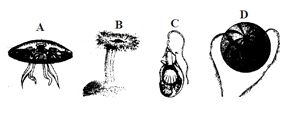
A - Pleurobrachia, B - Cnidoblast, C - Aurelia, D - Adamsia
A - Aurelia, B - Adamsia, C - Cnidoblast, D - Pleurobrachia
A - Cnidoblast, B - Pleurobrachia, C - Adamsia, D - Aurelia
A - Adamsia, B - Aurelia, C - Pleurobrachia, D - Cnidoblast
Which of the following belong to phylum arthropoda?
Bombyx and Apis
Laccifer and Anopheles
Locusta and Limulus
All of the above
The figure given below is the characteristic structure of the phylum in which animals are aquatic, free swimming or sessile, mostly marine, radially symmetrical. Identify the phylum and correct function of the structure.

Ctenophora; Emission of light.
Porifera; Feeding, respiration and excretion.
Cnidarian; Anchorage, Defense and food capturing
Mollusca; Locomotion, transport of food and respiration.
Which of the following is a fresh water sponge?
Sycon
Euspongia
Spongilla
Pleurobrachia
Identify the figure with its correct name and phylum.
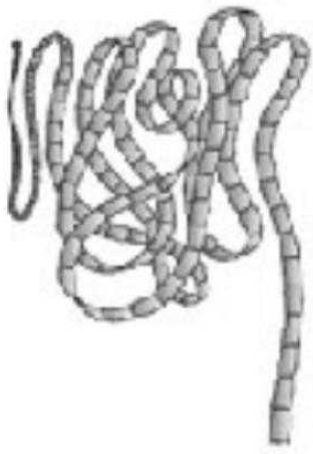
Sycon - Porifera
Aurelia - Coelenterata
Pleurobrachia - Ctenophora
Tapeworm - Platyhelminthes
Examine the figures A, B and C. In which one of the four options all the items A, B and C are correctly identified ?

A - Sycon, B - Euspongia, C - Spongilla
A - Euspongia, B - Spongilla, C - Sycon
A - Spongilla, B - Sycon, C - Euspongia
A - Euspongia, B - Sycon, C - Spongilla
In amphibians, respiration occurs through
gills
lungs
skin
all of these
The figure given below shows the germinal layers marked as A, B, C and D. Identify the label showing undifferentiated layer and its location?
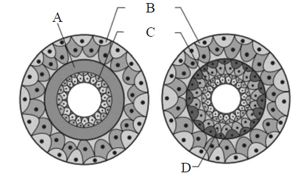
A, Between B & C
B, Between A & C
C, Between C & D
D, Between A & B
In which of the phylum, excretory organ like proboscis gland is present?
Hemichordata
Chordata
Echinodermata
Annelida
Which of the following is not a characteristic feature of kingdom animalia ?
Storage of carbohydrates as starch.
Multicellularity.
Obtaining nutrients by ingestion.
Having eukaryotic cells without walls.
Which of the follwoing statement(s) is/are correct?
(i) Organ systems in different group of animals show various patterns of complexities.
(ii) The digestive system in platyhelminthes has only a single opening to the outside of the body that serve as both mouth and anus, and is hence called complete.
(iii) In open type of circulatory system, the blood is pumped out of the heart and the cells and tissues are directly bathed in it.
(iv) In closed type, the blood is circulated through a series of vessels of varying diameters (arteries, veins and capillaries).
Only (i)
Both (ii) and (iii)
(i), (iii) and (iv)
All of these
Refer the types of cells present in some animals. Each cell is specialized to perform a single specific function except
Cnidocytes
Choanocytes
Interstitial cells
Gastrodermal cells
Which of the following characteristic is probably most responsible for the great diversification of insects on land ?
Segmentation
Antennae
Bilateral symmetry
Exoskeleton
Tracheae of cockroach and mammal are similar in having
paired nature.
non-collapsible walls.
ciliated inner lining.
origin from head.
__________ is responsible for maintaining the current of water in sponge.
Osculum
Porocytes
Spongocoel
Choanocytes
The transition from aquatic to terrestrial lifestyles required many adaptations in the vertebrate lineage. Which of the following is not one of those adaptations ?
Switch from gill respiration to air-breathing lungs.
Improvements in water resistance of skin.
Alteration in mode of locomotion.
Development of feathers for insulation.
Which of the following statements is incorrect ?
Prawn has two pairs of antennae.
Nematocysts are characteristic feature of the phylum cnidaria.
Millipedes have two pairs of appendages in each segment of the body.
Animals that belong to phylum porifera are exclusively marine.
Match the characteristic feature/terms given in column I with the phylum to which they belongs given in column II and choose the correct option.
| Column-I | Column-II |
|---|---|
| (Characteristic feature/term) | (Phylum) |
| A. Choanocytes | I. Platyhelminthes |
| B. Cnidoblasts | II. Ctenophora |
| C. Flame cells | III. Porifera |
| D. Nephridia | IV. Coelenterata |
| E. Comb plates | V. Annelida |
A II; B I; C IV; D V; E III
A II; B IV; C I; D V; E III
A V; B I; C III; D II; E IV
A III; B IV; C I; D V; E II
Which of the following statement(s) is/are correct regarding phylum aschelminthes?
(i) The body is circular in cross-section hence the name roundworms.
(ii) Alimentary canal is complete with a well-developed muscular pharynx.
(iii) Sexes are separate (dioecious), i.e., males and females are distinct.
(iv) Nephridia help in osmoregulation and excretion.
(i) and (ii)
(iii) and (iv)
(i), (ii) and (iii)
All of these
Which of the following group of animals belongs to the same phylum?
Earthworm, pinworm, tapeworm
Prawn, scorpion, Locusta
Sponge, Sea anemone, starfish
Malarial parasite, Amoeba, mosquito
Which of the following is an incorrect statement regarding flatworms ?
They are acoelomates.
They are bilaterally symmetrical.
They lack a digestive system.
They have a circulatory system.
In amphibians, heart is ________ chambered.
two
three
four
none of these
Flame cells present in platyhelminthes, are specialized in
respiration and absorption.
osmoregulation and circulation.
respiration and excretion.
osmoregulation and excretion.
Which of the following animal's body is covered by calcareous shell and unsegmented with a distinct head, muscular foot, and visceral hump?
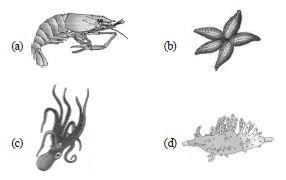
Click to check answer
Click to check answer
Click to check answer
Click to check answer
Identify the figures and select the correct option
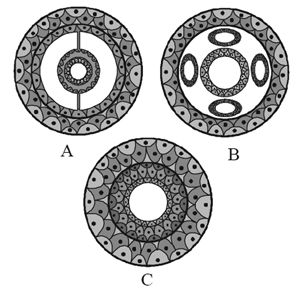
A - Pseudocoelomate; B - Coelomate, C-Acoelomate
A - Coelomate, B - Pseudocoelomate, C- Acoelomate
A - Coelomate; B- Acoelomate; C - Pseudocoelomate
A - Coelomate; B- Acoelomate; C-Eucoelomate
Which of the following possesses electric organs and belongs to class chondrichthyes?
Torpedo
Petromyzon
Trygon
Exocoetus
Which of the following statement(s) is/are correct?
(i) Animals in which the cells are arranged in two embryonic layers, an external ectoderm and an internal endoderm, are called diploblastic animals.
(ii) Notochord is an ectodermally derived rod like structure formed on the ventral side during embryonic development in some animals.
(iii) In some animals, the body cavity is not lined by mesoderm, instead, the mesoderm is present as scattered pouches in between the ectoderm and endoderm and such a body cavity is called pseudocoelom.
Only (i)
Both (i) and (ii)
Both (i) and (iii)
All of these
The given figures A, B, C and D are the examples of first true land vertebrates. They are dominant in mesozoic era and belong to phylum ‘X’. Identify ‘X’ and the animals which have four chambered heart.
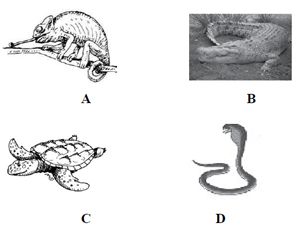
X – Reptile; B
X – Reptile; A
X – Amphibia, C
X – Pisces; D
Which of the following character is absent in all chordates?
Diaphragm
Coelom
Pharyngeal gill clefts
Dorsal nerve cord
Which of the following class is being correctly described by given statements (i - iv)?
(i) All living members of this class are ectoparasites on some fishes.
(ii) They have a sucking and circular mouth without jaws.
(iii) Circulation is of closed type.
(iv) They are marine but migrate for spawning to fresh water. After spawing, within a few days they die.
Cyclostomata
Chondrichthyes
Osteichthyes
Amphibia
